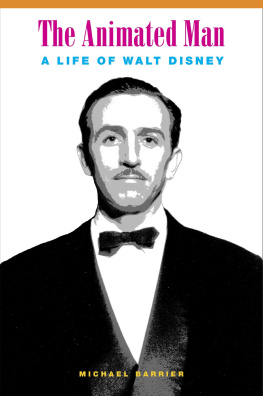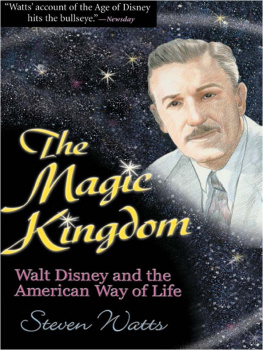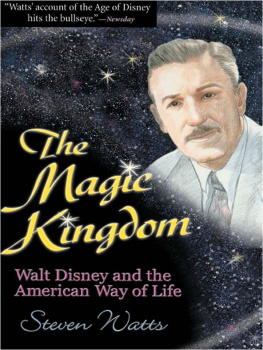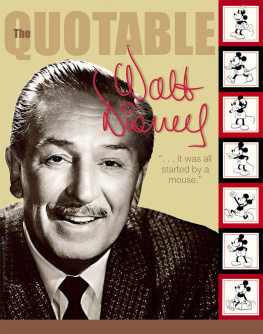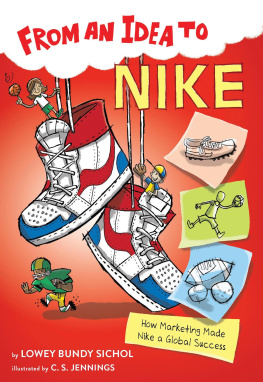ACKNOWLEDGMENTS
This book draws heavily on research I conducted for Hollywood Cartoons: American Animation in Its Golden Age, my history of Hollywood studio animation. Milton Gray, the animator who provided me with invaluable assistance during my work on that book, deserves just as much thanks for his contribution to The Animated Man: A Life of Walt Disney, even though I did not impose on him nearly as much this time around. I could use only a small part of the valuable information he gathered for me in the first book, and with this book I have made only another small dent in the accumulation.
I am grateful for the same reason to Mark Kausler, the greatest student of Hollywood animation. Without all the help he gave me in writing the first book, I could never have written this one. In writing about Walt Disney I have also received valuable help from my friends Robin Allan and J. B. Kaufman, two of the people most deserving of the much-abused title animation historian.
Kaye Malins, the greatest booster for Marceline, Missouri, the little railroad town where Walt grew up, gave my wife, Phyllis, and me a wonderful tour on a rainy morning in March 2005, and she has been a great help in other ways. Michael Danley helped me locate many rare documents. Paul F. Anderson provided me with missing issues of The E Ticket and his own excellent magazine about Disney, Persistence of Vision. Keith Scott, the greatest authority on cartoon voices, sent rare audiotapes of Walt Disneys radio performances in the 1930s and 1940s. Gail Fines, May Couch, and Craig Pfannkuche were of invaluable help in finding markers of the Disney familys life in the public records of Kansas City, Marceline, and Chicago, respectively.
I have enjoyed assistance from dedicated people at many libraries, archives, and other organizations, but especially the following:
David R. Smith and Robert Tieman of the Walt Disney Archives; Rosemary C. Hanes of the Motion Picture, Broadcasting and Recorded Sound Division of the Library of Congress, Washington; Ned Comstock of the Archives of Performing Arts and Dace Taube of the Regional History Collections at the University of Southern California, Los Angeles; Howard Prouty, Barbara Hall, and Faye Thompson of the Margaret Herrick Library, Academy of Motion Picture Arts and Sciences, Beverly Hills; Maria Morelli of the Howard Gotlieb Archival Research Center at Boston University; Carol Neyer, Lynn Rosenfeld, and Coco Halverson of the California Institute of the Arts, Valencia; Stine Lolk and Sven Hansen of Tivoli Gardens, Copenhagen; Sally McManus and Jeri Vogelsang of the Palm Springs Historical Society; Joan Blocher of Chicago Theological Seminary; Elizabeth Konzak of the University of Central Florida Libraries, Orlando; Carol Merrill-Mersky and Julio Gonzalez of the Hollywood Bowl Museum, Los Angeles; Fred Deaton of the Marshall Space Flight Center, Huntsville, Alabama; Janet Moat of the British Film Institute, London; Lillian Hess of the Danish Tourist Board, New York; Elaine Doak of the Picker Memorial Library at Truman State University, Kirksville, Missouri; Sara Nyman of the Kansas City, Missouri, Public Library; Eric Lupfer of the Harry Ransom Humanities Research Center, University of Texas at Austin; Michelle Kopfer of the Dwight D. Eisenhower Library, Abilene; Carol Martin of the Harry S. Truman Library, Independence; Lisa L. Bell of Smoke Tree Ranch, Palm Springs; Martha Shahlari of the Jannes Library at the Kansas City Art Institute; Por Hsyu of the Burbank Public Library; and the interlibrary loan staff of the Central Arkansas Library System.
Phyllis Barrier, Milton Gray, J. B. Kaufman, and Mark Kausler read the manuscript and made many helpful suggestions.
During my work on Hollywood Cartoons, around 150 people who worked for Walt Disney or knew him in other settings sat for interviews with me or Milton Gray, or with both of us, mostly in person but sometimes by telephone. Others provided full tape-recorded responses to my written questions. Many of the people who sat for interviews also answered my questions in letters and provided me with documents of various kinds. It is a source of deep regret that so many of the people on the following list are no longer here to read this book. I regret too that not everyone on the list is represented in the text, but they all contributed to my understanding of Walt Disney and his work. I am grateful to:
Edwin Aardal, Ray Abrams, Kenneth Anderson, Michael Arens, Arthur Babbitt, Carl Barks, Aurelius Battaglia, Ed Benedict, Lee Blair, Mary Blair, Preston Blair, Billy Bletcher, James Bodrero, Stephen Bosustow, Jack Boyd, Jack Bradbury, Jameson Brewer (known in the 1930s as Jerry), Homer Brightman, Bob Broughton, Jack Bruner, Robert Carlson, Jim Carmichael, Marge Champion, Donald Christensen, Ivy Carol Christensen, Bob Clampett, Les Clark, Claude Coats, William Cottrell, Chuck Couch, Jack Cutting, Arthur Davis, Marc Davis, Robert De Grasse, Eldon Dedini, Nelson Demorest, Philip Dike, Eyvind Earle, Mary Eastman, Phil Eastman, Jules Engel, Al Eugster, Carl Fallberg, Paul Fennell, Marceil Clark Ferguson, Eugene Fleury, Hugh Fraser, John Freeman, Friz Freleng, Gerry Geronimi, Merle Gilson, George Goepper, Morris Gollub, Campbell Grant, Joe Grant, Richard Hall (known in the 1930s as Dick Marion), David Hand, Jack Hannah, Hugh Harman, Jerry Hathcock, Gene Hazelton, T. Hee, John Hench, David Hilberman, Cal Howard, John Hubley, Richard Huemer, William Hurtz, Rudolph Ising, Willie Ito, Wilfred Jackson, Ollie Johnston, Chuck Jones, Volus Jones, Milt Kahl, Lynn Karp, Van Kaufman, Lew Keller, Hank Ketcham, Betty Kimball, Ward Kimball, Jack Kinney, Earl Klein, Phil Klein, Fred Kopietz, Eric Larson, Gordon Legg, Fini Rudiger Littlejohn, Hicks Lokey, Ed Love, Richard Lundy, Eustace Lycett, James Macdonald, Daniel MacManus, C. G. Max Maxwell, Helen Nerbovig McIntosh, Robert McIntosh, Robert McKimson, J. C. Bill Melendez, John P. Miller, Dodie Monahan, Kenneth Muse, Clarence Nash, Grim Natwick, Maurice Noble, Dan Noonan, Cliff Nordberg, Les Novros, Edwin Parks, Don Patterson, Bill Peet, Hawley Pratt, Martin Provensen, Thor Putnam, Willis Pyle, John Rose, George Rowley, Herb Ryman, Leo Salkin, Paul Satterfield, Milt Schaffer, Zack Schwartz, Ben Sharpsteen, Mel Shaw (known in the 1930s as Mel Schwartzman), Charlie Shows, Larry Silverman, Joe Smith, Margaret Smith, Carl Stalling, McLaren Stewart, Robert Stokes, John Sutherland, Howard Swift, Frank Tashlin, Frank Thomas, Richard Thomas, Clair Weeks, Don Williams, Bern Wolf, Tyrus Wong, Cornett Wood, Adrian Woolery, Ralph Wright, Rudy Zamora, and Jack Zander.
In addition, Marcellite Garner Lincoln, Tom McKimson, and Claude Smith provided helpful information through letters, and Fred Niemann shared his correspondence with Frank Tashlin.
After I began work on this book, I interviewed fifteen more people whose paths crossed Walt Disneys. I am grateful to:
Ken Annakin, Kathryn Beaumont, Frank Bogert, Jim Fletcher, Sven Hansen, Richard Jenkins, James MacArthur, Floyd Norman, Fess Parker, Harrison Buzz Price, Maurice Rapf, Norman Tate, Dee Vaughan Taylor, Richard Todd, and Gus Walker.
As indicated in the notes, I have been granted access over the years to the personal papers of a number of people who worked on the Disney films. I am indebted to the following people for that access: to Nick and Tee Bosustow, for items from the papers of their late father, Stephen Bosustow; to Mrs. David Hand, for items from her late husbands papers; and to the late Polly Huemer, for items from her late husbands papers, in addition to those that Dick Huemer himself permitted me to copy.
At the University of California Press, Mary Francis, Rachel Berchten, and Kalicia Pivirotto have made transforming my manuscript into a book an exceptionally pleasant experience. And thanks also to Edith Gladstone for her scrupulous, attentive editing.

